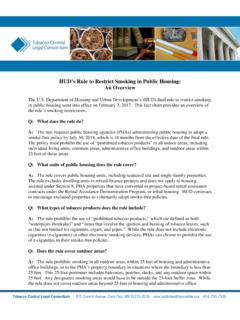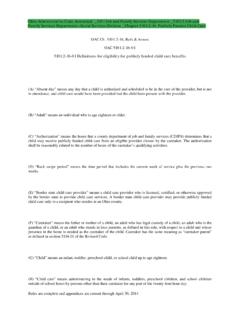Transcription of Laws, Policies and Regulations: Key Terms & Concepts
1 laws , Policies and regulations : Key Concepts and Terms /1 Fact Sheet laws , Policies and regulations : Key Terms & Concepts This fact sheet is designed to shed light on what can often be a confusing area in public health: the differences between legislative and administrative Terms such as laws , Policies , rules and regulations . The definitions below are brief, general, and restricted to tobacco control examples. At the very least, they illustrate a few of the most common ways federal, state, local and tribal governments use their power and authority to safeguard public health. Q: What s the difference between Congressional Acts and federal regulations ? A: The Congress passes national laws (often called Acts) to address social, health or economic needs or problems.
2 The Clean Air Act, the Food, Drug and Cosmetic Act, and the Family Smoking Prevention and Tobacco Control Act are all examples of landmark federal legislation that address public health issues. The appropriate regulatory agencies those empowered to enforce the Acts are authorized to adopt regulations that implement These regulations , which have the force of law, fill gaps in the legislation and help agencies carry out their duties and mission, as defined in the Acts. The federal regulations thus stem from the For instance, the Family Smoking Prevention and Tobacco Control Act authorizes the Food and Drug Administration (FDA) to create the regulations required to regulate the manufacture, sale and marketing of tobacco products.
3 Q: What are statutes? A: Statutes are laws (or acts) enacted by legislatures. Federal statutes are passed by the Congress and become law if (1) the President signs them into law or (2) the President does not return the bills to Congress with objections within a given time period or (3) Congress overrides the President s veto of the bills and passes them with a 2/3 majority in both houses. Federal statutes are published as public and private laws , and as codified For more information about federal statutes, see the Library of Congress s website. laws , Policies and regulations : Key Concepts and Terms /2 Just as the Congress is responsible for creating laws at the national level, state legislatures are responsible for enacting laws at the state level.
4 State statutes are general laws that apply throughout a These laws cover many areas, including public health, and also create public health agencies and boards of health, define their missions and core functions, and grant them State statutes are compiled and set forth in publications that go by a variety of names, depending on the state. Examples of these codes of state statutes are the North Dakota Century Code, Montana Code Annotated, and Ohio Revised Code. Although all statutes are laws , not all state laws are statutes. Some examples of state laws that are not statutes are appropriation laws (which are often temporary). Statutes, on the other hand, include the general and permanent laws of a state. Q: What s the difference between a statute and an ordinance?
5 A: Unlike a statute, or state law, an ordinance is a local law that is passed by municipal governing authorities, such as a city council or county board of commissioners. Ordinances also apply only to the local jurisdiction, as opposed to the entire state. Many communities, for example, use tobacco control ordinances to regulate the use, sale or distribution of tobacco products in their localities. Ordinances typically provide an enforcement measure that includes penalties of some type. Q: What are board of health regulations ? A: Many state statutes grant local boards of health the authority to pass public health rules and regulations , including tobacco use prevention and control measures. Because the role of boards of health varies by jurisdiction, these measures may be adopted by the board or the local governing body for public health, such as a city council, county board of commissioners, or tribal board.
6 For more information about board of health regulations , see the Tobacco Control Legal Consortium s Tips and Tools, Local Board of Health Authority for Tobacco Control. Q: What s the difference between statutes and a state s administrative codes (or rules)? A: As mentioned above, state statutes are state laws passed by the legislature. A state s administrative codes, on the other hand, are created by an office or agency of the state under authority granted by the legislature. Administrative codes have the force and effect of law and consist of rules and regulations that interpret the requirements of an office or agency. State statutes and rules and regulations can also regulate the same conduct within a state. For example, a state s smoke-free law might, in part, prohibit smoking in childcare facilities.
7 The same state s administrative agency might also pass rules or regulations that prohibit smoking in child care facilities as a part of its licensing requirements. Although the statutory and administrative code requirements may be similar and are equally legally binding, the implementation and enforcement process, penalties and agents vary, depending on the law or regulation. laws , Policies and regulations : Key Concepts and Terms /3 Q: How does a policy differ from a law? A: The phrase public policy is often used broadly to include laws , rules, and regulations intended to accomplish certain goals. One scholar defines public policy, for example, as a system of laws , regulatory measures, courses of action, and funding priorities concerning a given topic promulgated by a governmental entity or its representatives.
8 6 Under this definition, tobacco control Policies would include such measures as smoke-free ordinances, tobacco advertising restrictions, point-of-sale strategies, tobacco coupon regulations , and cigarette minimum pricing laws . In a narrower sense, tobacco control Policies often differ from tobacco control laws in the way they are enforced and the consequences of noncompliance. For example, violation of a smoke-free parks policy might result in eviction from the premises, but violation of a smoke-free parks ordinance could result in monetary penalties for a petty misdemeanor or even a misdemeanor. Similarly, violation of a worksite smoke-free policy could result in an employee being reprimanded, suspended, or even (in some circumstances) terminated, whereas violations of smoke-free and other tobacco control laws could result in civil and administrative penalties, including the suspension or revocation of business permits or licenses.
9 Q: What are guidance documents? A: Federal regulatory agencies, such as the FDA, often publish guidance documents to help define standards or expectations that are part of a rule or regulation. Guidance documents serve many important functions in regulatory programs. The FDA, for instance, often uses guidance documents to help interpret existing law, provide current agency thinking on an issue, or clarify how it might treat or enforce a governing legal Q: What s a notice and comment period ? A: Governmental agencies typically publish a notice that they intend to add, remove, or change a rule or regulation as part of the rulemaking process. (See Federal Register below.) They give a period of time that the public can comment on the proposed rule or regulation.
10 The regulation cannot take effect until after this period expires. Q: What s the Federal Register? A: The Federal Register publishes federal agency regulations and other legal documents of the executive branch on a daily basis, including proposed changes (rules, regulations , standards, etc.) of governmental Some published proposed changes include invitations for any citizen or group to participate in the consideration of the proposed regulation by submitting written data, views, or arguments, or even oral presentations. The Federal Register s notices of proposed rulemaking generally include: 1. A statement of the time, place, and nature of the proposed rulemaking proceeding; 2. A reference to the authority under which it is issued; laws , Policies and regulations : Key Concepts and Terms /4 3.










